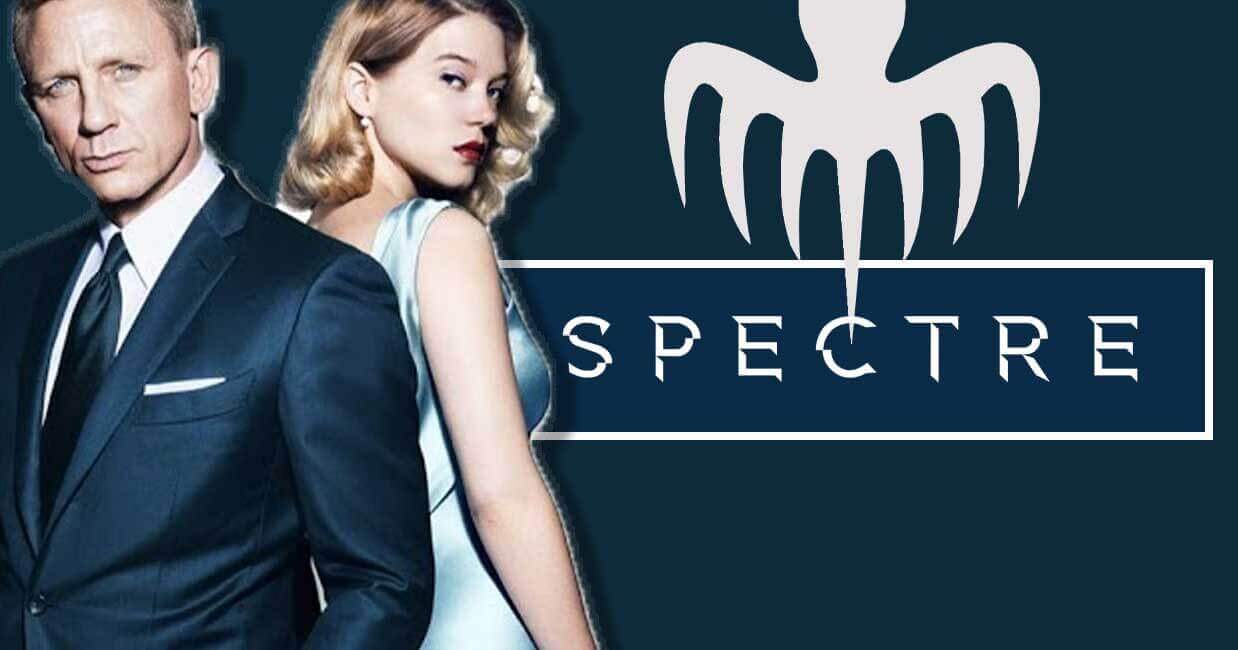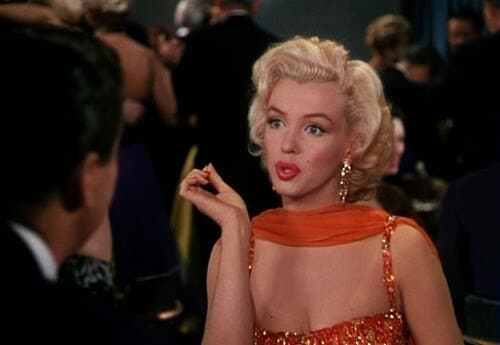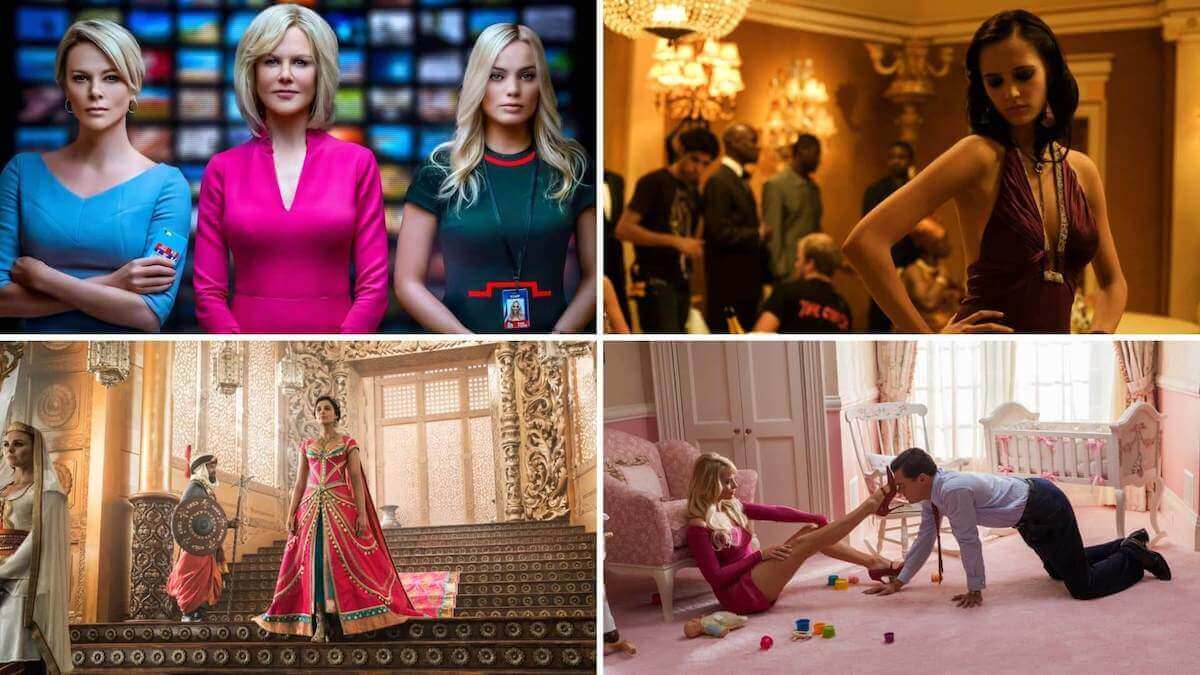Whenever you hear someone talking about the male gaze, you may be asking yourself, “What is the male gaze?” Well, in this post we’re going to tell you. We’re going to explain what we mean by the term “the male gaze” and we’ll show you some examples from recent films. We’ll also give you some suggestions for how you can subvert the male gaze and create a more balanced visual narrative.
Theory
Where did the male gaze come from?
What is the male gaze? Filmmaker and theorist Laura Mulvey first coined the term “the male gaze” in her seminal 1973 paper Visual Pleasure and Narrative Cinema. Mulvey’s essay, published two years later in Screen magazine, was written for an academic audience so it can be a little difficult to understand.
Let’s try to break down her main points, one by one.
THE MALE GAZE
“In a world ordered by sexual imbalance, pleasure in looking has been split between active/male and passive/female.”
First of all, Mulvey was talking about how our society is structured by, and for the benefit of heterosexual men (i.e., “the Patriarchy”). Men are considered the “active” do-ers of the world, while women are expected to take a more “passive” role supporting the men and/or men’s goals.

Bond’s co-stars are passive helpers
In the context of cinema, it’s mostly men who write the films we watch, mostly men who make those films, and it is men who are usually the target audience.
Therefore, men are usually given the lead in the stories themselves while female characters are assigned functions that are limited to serving the goals of those male protagonists.
Remember, Mulvey was writing an academic paper for an academic audience. So, when she talks about “pleasure in looking,” she’s referring to the notion (taken from psychology) that part of why we love movies is because we enjoy watching people without being seen ourselves.
While we may or may not agree with that idea, it’s important to understand for getting into Mulvey’s next point.
THE MALE GAZE
“The determining male gaze projects its fantasy onto the female figure… with [her] appearance coded for strong visual and erotic impact.”
“The determining male gaze” is what happens when we put it all together.
Men writing the films, men making the films, men being the protagonists, and men being the target audience all combine into a unified — heterosexual male — perspective of female characters.
In other words, we all been conditioned to adopt the male gaze because that is the way we were “raised” by traditional cinema.
THE MALE GAZE
“Traditionally, the woman displayed has functioned on two levels: as erotic object for the characters within the screen story, and as erotic object for the spectator within the [cinema] auditorium.”
Female characters must perform their story function while also adhering to the heterosexual male sexual fantasy — though not always in a literal way. Simply being beautiful (or “sexy”) is all that’s needed.
Let’s clarify with an example. In the following scene from Fast Five, Gisele (Gal Gadot) and Han (Sung Kang) have been tasked with getting the bad guy’s fingerprints.
This scene is a perfect illustration of what each aspect of Laura Mulvey’s male gaze looks like in practice.
Notice how the very first thing Gisele does to accomplish her part of the mission is strip down to her bikini. Next, the camera shifts to super sexy slo-mo to catch each tiny movement Gisele’s body makes — which gives us time to notice that many of the other women in the frame are just as scantily clothed.
A Woman's Job • Fast Five
Because this is Han’s point of view, the camera lingers on Gisele’s every move from a slight distance. But ultimately, we punch in on her bum because that’s where the bad guy puts his hand — which is what Gisele wants to happen.
We accept all this because we know Gisele is in on the whole thing — that it’s her idea, even. But in fact, the character of Gisele is being used to achieve something the male protagonist needs.
Now that we have a sense of what to look for, let’s practice being able to recognize the male gaze.
Practice
Recognize the male gaze
We know that the male gaze objectifies female characters. But more importantly, the male gaze also reaffirms the power of the Patriarchy to use women as props in service of the heterosexual male narrative.

Mulvey quotes director Budd Boetticher
In other words, a female character doesn’t have to be overly sexualized to be the object of the male gaze, Mulvey explains. What matters is that she incites (passive) the male protagonist to take action (active) toward his ultimate goal.
Mulvey wrote her essay some 50 years ago, so she was mostly referring to the Classical era of mainstream cinema. Let’s look at an example that fits Mulvey’s references a little better.
Aladdin is a traditional family film that was released in 2019. Though 21st century Jasmine has her own goals and stands up for herself throughout the film, she is still objectified by the story and every man in it.
Princess Jasmine • Aladdin
To her Sultan father, Jasmine (Naomi Scott) is a precious artifact locked away for safekeeping. To the villain Jafar (Marwan Kenzari), Jasmine is a valuable commodity to be obtained for greater power and influence.
And to Aladdin (Mena Massoud), the hero, Jasmine is a prize to be won. Which he ultimately does, with the help of his trusty sidekick, Genie (Will Smith).
The other element of the male gaze we need to talk about is the camera itself. Where we place the camera, and what we include in the frame (camera framing), is just as important to how we view female characters as the way they are written in the screenplay.
Bombshell recounts the story of how multiple female on-air talent at Fox News came forward to disclose how they had been sexually harassed (or worse) by sexual predator Roger Ailes (John Lithgow).
Bombshell • Kayla's "Audtition"
Notice that, rather than placing the camera so the audience identifies with Kayla (Margot Robbie), the woman being victimized, the director’s choice of camera placement — and particularly of framing — has us identifying with the sexual predator instead. In his analysis of "Bombshell," Jay Roach provided unique insights into the challenges of portraying real-life events on the big screen.
And let’s compare these scenes from two different James Bond films.
In Die Another Day, Halle Berry’s “Jinx” is objectified by both James Bond (Pierce Brosnan) and the camera in the same way as Gisele in Fast Five, including the sexy slo-mo.
Jinx Scene • Die Another Day
But when Bond himself emerges from the water in Casino Royale, there’s no slo-mo, no binoculars. In fact, the cross cutting between Bond (Daniel Craig) and the woman with the horse (Catarina Murino) tells us that they make eye contact, not that she’s ogling his body.
Okay, so now that we know what the male gaze looks like, even when it’s not overtly sexual, what can we do to switch things up?
Innovate
Subvert the male gaze
We subvert something by taking away its power, especially in the context of a long-accepted social construct, like the Patriarchy. With this in mind, how can we subvert the male gaze in our filmmaking choices?
One way is to draw attention to it; and a good way to do that is by swapping genders. Take a role a woman always plays and cast a man instead.

Marilyn Monroe • The Archetypical Bimbo
For example, the Bimbo is a character women have been playing since films first had sound. What the Bimbo lacks in intellect is more than balanced out by her physical attractiveness.
But unless she’s Marilyn Monroe, who made an entire career playing this character, the Bimbo usually has very little function in the overall plot.
She is sometimes the “love interest” (i.e., lusted after) for one of the male characters, but her main purpose in the story is eye candy for the male audience members.
Ghostbusters subverts the male gaze by casting Chris Hemsworth to play the Bimbo instead. Hemsworth’s Kevin Beckman is the only male of the group, is lusted after by Erin (Kristen Wiig), and he’s dumber than a box of rocks.
The Receptionist • Ghostbusters
Kevin also gets possessed in the final act of the film by the (dead) bad guy, Rowan — which is still very much a part of the usual male gaze tropes. Doing something to the “love interest” is a standard plot point that draws out the hero to the final confrontation.
Kevin Possessed • Ghostbusters
In other words, Rowan possesses Kevin, not because of anything Kevin personally says or does, but because it’s a way to attack the Ghostbusters and force them into the final battle sequence.
As an added bonus, Rowan also revels in the experience of what it’s like to be physically strong and attractive.
TROPE DEFINITION
WHAT IS A TROPE?
A trope is a story element (character, plot point, etc) that is so common, it’s immediately recognizable. Similar to a cliché, but not necessarily with the same negative connotations.
Jumanji: Welcome to the Jungle also does a good job of subverting the male gaze. In this story, a group of high schoolers are magically sucked into a video game where they appear as their game avatars.
This means casting adult actors to play teenagers. Jack Black plays the avatar (“Shelly Oberon”) chosen by Bethany (Madison Iseman).
Bethany Learns to Pee • Jumanji
In general, Jumanji: Welcome to the Jungle calls out many of the tropes common in video games, not the least of which is how the male avatars are all fully covered while Martha’s avatar, Ruby Roundhouse (Karen Gillan), is wearing only a crop top and skimpy shorts.
In the following scene Martha is sent to distract the male guards so her friends can sneak into the aircraft hangar. They watch her from a distance waiting for their chance.
Martha's Sexy Dance Fighting • Jumanji
This scene subverts the male gaze on multiple fronts. First, because the teenage Martha has no idea or experience of how to be “sexy.” So she does her best to imitate the tropes we’ve already discussed.
Meanwhile, the camera simulates watching her through binoculars, giving us her friends’ perspective in the same way we saw earlier in Die Another Day. But unlike Bond, Martha’s friends are not titillated by her body in the slightest.
In fact, they express concern for her well-being. What’s more, the “non-player character” guards are totally ignorant of the male gaze and so are incapable of even understanding what Martha is doing.
Conclusion
Remember these things
So, let’s recap. The main thing to remember about Laura Mulvey’s male gaze is that it’s the perspective of the heterosexual male fantasy.
In writing, the male is the strong, confident protagonist and the female characters are there to serve his story. Female characters can be overly sexualized objects of desire, or simply there to tend to his wounds and support him in reaching his goal.
In filming, the male gaze is represented by the camera. It lingers over the female body in ways meant to titillate both the male protagonist and the audience. It frames the female body in sections and dehumanizes her.
UP NEXT
How to avoid stereotypes in movies
The same way the male gaze promotes a certain ideology about females characters, other stereotypes also persist. Let's briefly go over the stereotypes that the film industry has perpetuated along with some films and TV shows that are redefining the cultural landscape.
Up Next: Avoiding stereotypes →
Showcase your vision with elegant shot lists and storyboards.
Create robust and customizable shot lists. Upload images to make storyboards and slideshows.
